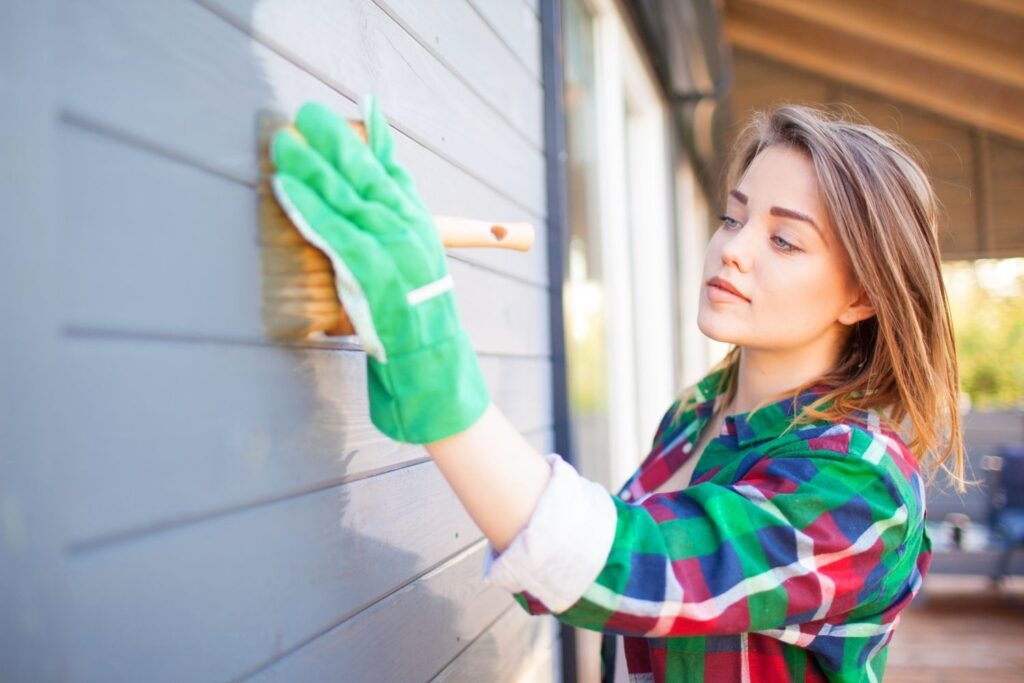Are you planning a new paint project for your home? In today’s post, you’ll find all the information you need on the difference between interior and exterior paint.
Different paints are created with different goals in mind. For example, the exterior walls of your home often face rainy days, snowstorms, and strong winds. As such, exterior paints are made to resist extreme weather conditions, mildew, and mold.
On the other hand, your interior walls are likely to get stained — especially if you have pets or children around. And so, interior paint should be easy to scrub clean without getting damaged. It is also more stain-resistant than exterior paint, and is designed to be safer to breathe around.
But to fully understand the difference between exterior and interior paint, we must jump into the chemistry behind each — exactly the purpose of this blog post. So, let’s dig in!

This post may contain affiliate links and we may earn commissions when you click on the links at no additional cost to you. See our disclosure policy for more details.
Basic Paint Ingredients
Before delving into the details, let’s get the basic paint ingredients out of the way. We have four main ingredients that are essentially the same for all types of paints:
Solvent
The solvent is what makes the paint wet. It dissolves all other ingredients of the paint to form a runny mixture.
As the paint gradually dries, the solvent evaporates into the air. This hardens the paint, leaving behind the remaining three ingredients.
The solvents are usually either:
- Oil — Oil-based paints are slower to apply and usually have a thicker, stickier feel. These are mostly used for exterior paints.
- Water — Water-based paints are easy to apply, quick to dry, and convenient to clean. They are common in both exterior and interior paints.
Pigment
A navy blue room … A citrine yellow accent wall … Wondering what makes your paint oh-so-colorful? Pigment!
Pigment is finely-ground, insoluble material added to the mixture. It can be natural (plant or animal-based) or synthetically produced.
Generally, pigments share similar properties for both interior and exterior paints.
Additives
Additives give the paint different properties and help improve its overall look and performance. For example, they can make the paint resistant to UV rays, water, and mildew. They also provide good flow to the paint and make it more durable.
Resins
Resins have adhesive properties, i.e., they bind the paint to the wall. Resins typically consist of acrylic, epoxy, or silicone.
Exterior paints use harsher, more elastic resins to cater to changing weather conditions. Interior paints, on the other hand, have more rigid resins.
What is the Difference Between Interior and Exterior Paint?
Now that you know what paints are made of — and where differences arise in terms of ingredients — let’s delve into a deeper overview of each type of paint!
Overview Of Interior Paint

Interior paint is made for indoor use, and aims at decoration and aesthetics. So, you can expect it to have low durability (including easier cracking and flaking) but easy maintenance.
Most interior paints are also washable, so you can scrub them clean with a mixture of water and dish soap. This helps get rid of any stains, including those caused by pets and children.
Because interior paints aren’t exposed to sunlight, they are not made fade-resistant. If direct sunlight were to fall upon interior paint, it would quickly lose its color.
At the same time, interior paint is curated to withstand abrasion — one of the reasons why you can scrub it without causing damage. But because it is used indoors, it is made more delicate than exterior paint.
Finally, interior paint is made while minimizing any health risks. It has little to no VOCs (volatile organic compounds) — which can cause irritation to the eyes, nausea, and other health problems. The reduced use of VOCs also preserves the quality of air indoors.
Overview Of Exterior Paint

Exterior paint is made for exterior use, so its characteristics are tailored accordingly, too. First and foremost, exterior paint is highly weatherproof. It can withstand rain, snow, sleet, and hail without being damaged. Extra resins and additional additives help do the job.
Because it is exposed to direct sunlight, exterior paint is also made to be fade-resistant. It can receive hours of direct sunlight on end without losing its original color. Plus, this type of paint needs sunlight to cure — and it releases more VOCs as it cures, making it unsafe for indoor use.
Exterior paint also has high durability. This means it is not susceptible to flaking, chipping, cracking, and fungal growth. Generally, this is because soft resins are used in exterior paint, allowing for more flexibility.
Even if the wind were to pick up big pieces of debris and rocks and knock it against your walls, the paint would likely come out of the windstorm with its original beauty and charm!
So, Where Do the Differences Kick In?
Here are all the differences between interior and exterior paint in a nutshell:
- Interior paint uses organic pigments (that are safe to smell and don’t have harsh odors), while exterior paints may use non-organic, harsher pigments designed to resist fading.
- Interior paint uses silicone as the binding resin, while exterior paint uses more durable acrylic.
- Exterior paint is more durable and resistant to physical damage (including temperature, mildew, moisture, fading, and scratching) as compared to interior paint.
- As such, exterior paint also has more additives than interior paint to combat weather conditions.
- Interior paint is low in VOCs, while exterior paint is not.
- Exterior paint offers better adhesion — and also requires sunlight to cure, while interior paint does not.
- Exterior paint dries up at a faster rate, because it is exposed to constant airflow and heat.
What Happens if I Use Interior Paint Outside?
You could use interior paint outside, BUT …
It’s not going to last you long!
Interior paint isn’t designed to withstand extreme temperatures or weather conditions. So, even the slightest drizzle could wear out your paint, considerably reducing its lifespan.
Additionally, its gentle, organic pigments and little resistance to sunlight also mean it will lose its color after being exposed to sunlight. Interior paint also has less binding (and rigid) resins, so it will easily crack, powder, or flake.
FAQs
Before winding up this blog post, let’s answer some frequently asked questions related to the difference between interior and exterior paint to clear out any queries you may have in mind.
Can I use exterior paint indoors?
Exterior paint can cause outgassing (release of trapped gas). Although most of it occurs in the first 48 hours, it may continue in small amounts for multiple years. And the released gas can pose several health risks, so you surely wouldn’t want to use exterior paint indoors!
Is there a difference in price?
The price gap isn’t too much, but generally, exterior paint costs more than interior paint. This is because it has more additives, holds up better, and offers higher durability.
Conclusion
The difference between interior and exterior paint is considerable, with each catering to the needs of its environment.
As such, you should carefully read the tin while buying paint and choose the paint type according to the surface you aim to cover.
Read More:
Interior Painting Supply Checklist: What Supplies Do I Need To Paint A Room?
What’s the Best Paint Sheen for Bathrooms?
10 Best Paint Brands for Gorgeous Interior Walls
Painting Walls for Beginners: How to Paint a Wall by Yourself

